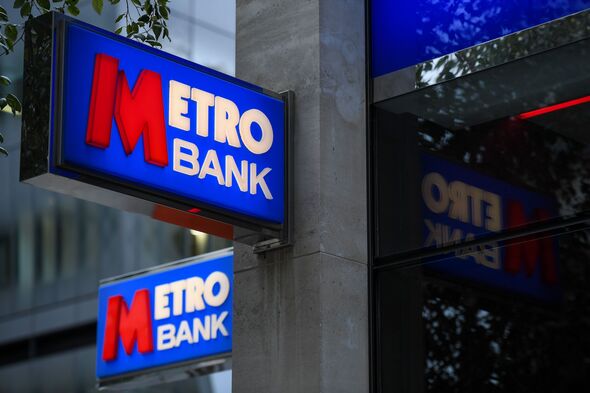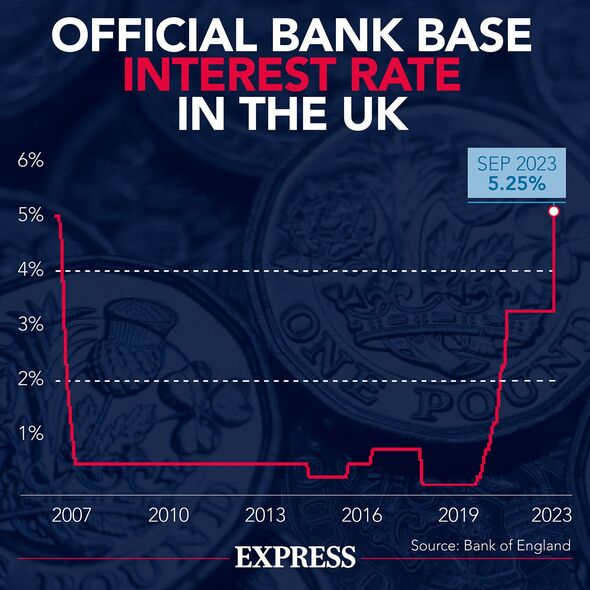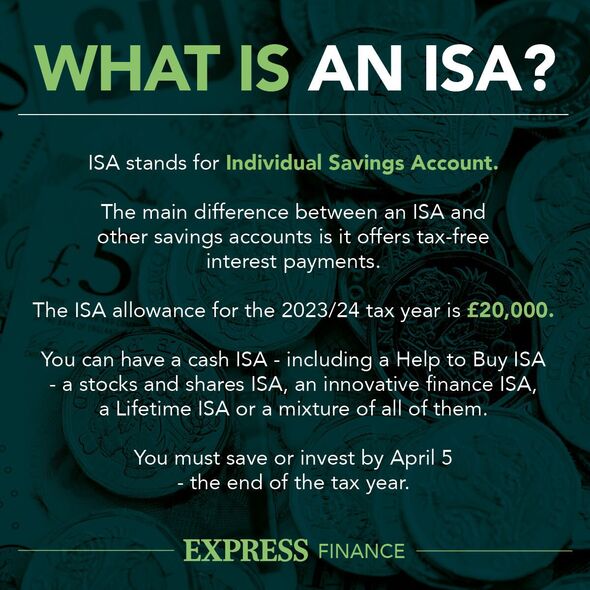
Best savings accounts this week offering interest rates up to 8% (Image: GETTY)
While the Bank of England Base Rate remains at a 15-year high of 5.25 percent, banks and building societies are still offering savers competitive returns on their money.
While savers aren’t able to cash in on the peak interest rates seen in the summer, some savings accounts are still paying rates of up to eight percent and a significant number of people are missing out.
According to research by Shawbrook Bank, almost a quarter of savers (24 percent) are earning two percent interest or less on savings despite the current average easy access rate standing much higher at 3.18 percent.
Challenger banks have been holding the top spots across a number of sectors, however, Rachel Springall, finance expert at Moneyfactscompare.co.uk noted: “They also act quickly to pull offers when they become fully subscribed. Consumers will need to act quickly to grab the top deals on offer and consider the more unfamiliar brands when comparing deals.”
There are a range of different accounts suitable for a variety of needs – from easy access accounts to fixed term savers – and some are still offering particularly attractive rates. Here are the top accounts on offer this week.

Metro Bank is offering a range of competitive savings accounts (Image: Getty)
Top easy access savings accounts
Easy access accounts are typically more flexible, as these allow savers to make payments and withdrawals with minimal restrictions and with small opening deposit requirements. Given the current high-living-cost environment, a survey from Hodge found more than half of respondents have had to dip into their savings for everyday expenses.
Topping the leaderboard of easy access savings accounts offering the highest interest rate is Metro Bank’s Instant Access Savings Account with an Annual Equivalent Rate (AER) 5.22 percent. At least £500 must be deposited within 28 days to earn the limited edition rate and interest is paid monthly. Access is allowed at any time in a branch, online, or by phone.
Ulster Bank’s Loyalty Saver falls just behind with an AER of 5.2 percent on deposits of over £5,000. Those with deposits lower than £5,000 will be paid a lower AER of 2.25 percent. Interest is paid annually and on account closure, and withdrawals are permitted at any time up to the daily limits.
For savers with a smaller deposit, Cahoot’s Simple Saver (Issue Two) is offering an AER of 5.12 percent. Cahoot, a division of Santander, offers savers the deal from a minimum deposit of just £1. Interest is calculated daily and can be paid annually or monthly and withdrawals can be made at any time by transfer to another account.

The Bank of England Base Rate has been frozen at 5.25 percent since September (Image: convey)
Top fixed rate savings accounts
Fixed-rate savers can be beneficial during the current period of falling rates, as these enable people to lock in an interest rate for a set length of time. However, they typically impose stricter withdrawal limits on customers, meaning savers should be comfortable investing money without needing to access it during the account term.
Al Rayan Bank tops the table for one-year fixed savings accounts with an Expected Profit Rate of 5.7 percent. The account can be opened with a minimum deposit of £5,000 and profit is paid quarterly. Up to £1million can be invested overall and withdrawals are not allowed until the term ends.
For two-year fixes, the Union Bank of India takes the top spot with an AER of 5.4 percent, dropping from 5.7 percent last week. The account can be opened with £1,000 and interest is paid on maturity. Up to £1million can be invested overall and withdrawals are not permitted.
Hanley Economic Building Society takes the direct for three-year fixes with an AER of 5.35 percent. The account requires a minimum deposit of £1,000 and interest is paid on maturity. Up to £75,000 can be invested and withdrawals are not permitted until the term ends.
The Bank of London and The Middle East tops the list for four-year fixed savings accounts with an Expected Profit Rate of 4.8 percent. The account can be opened with a minimum deposit of £1,000 and profit is paid annually and on maturity. Up to £1million can be invested overall and withdrawals are not permitted.
For longer-term savers, UBL UK takes the top spot for a five-year term with an AER of 4.81 percent. The account can be opened with a minimum deposit of £2,000 and up to £85,000 can be invested overall. Interest is paid on maturity and withdrawals are not allowed until the term ends.
- uphold fearless journalism
- Read The Daily convey online, advert free
- Get super-fast page loading
Regular savings accounts
Regular savings accounts can be a good option for those looking to get into a savings habit, as these accounts typically offer higher interest rates and the terms generally inspire savers to pay money into the accounts monthly.
Nationwide remains top of the regular savings account market with an AER of eight percent. The rate is fixed for 12 months and Britons can get started with just £1.
Interest is calculated daily and paid on maturity of the account exactly one year after opening. The rate is based on how many withdrawals a person makes in the year – if four or more are made, interest will drop to 2.15 percent. Savers can deposit up to £200 per month and savers must have a Nationwide Current Account to apply.
Online-based bank first direct falls just behind with an AER of seven percent. The rate is fixed for 12 months and Britons can get started with just £25.
Interest is calculated daily and paid on maturity of the account exactly one year after opening. Savers can deposit between £25 and £300 per month in multiples of £5. Withdrawals are not permitted throughout the 12-month term. In the event of this, the account will have to close and interest will be paid up to the closure date at the Savings Account variable rate instead.
Gatehouse Bank is also offering a competitive Expected Profit Rate of seven percent for 12 months. Gatehouse Bank operates under Sharia principles, which means profit is earned instead of interest. The account can be opened with a minimum deposit of £1 and people can save up to £300 a month. Profit is paid on maturity and withdrawals are not permitted until the term ends.
Top cash ISAs
Cash ISAs are a popular savings option, as these accounts enable people’s money to grow without having to pay tax on the interest above the Personal Savings Allowance (PSA). However, some ISAs can come with a few more restrictions, appreciate penalty charges for early access or transfers.
For those who need instant access to their cash ISA, Metro Bank tops the list with an AER of 5.11 percent. There is no minimum investment amount, interest is paid annually, and withdrawals can be made at any time.
In the fixed rate sector, Virgin Money’s Fixed Rate Cash ISA Exclusive (Issue 9) tops the list for one-year fixes with an AER of 5.51 percent. There is no minimum investment amount to get started, interest is applied annually, and earlier access will be subject to 60 days’ loss of interest.
Metro Bank is currently topping the table for two-year fixed ISAs with an AER of 5.01 percent. There is also no minimum opening deposit, interest is paid annually, and early access will be subject to 180 days’ loss of interest.
UBL UK takes the top spot for three-year fixes with an AER of 4.87 percent. The account can be opened with a slightly larger deposit of £2,000 and interest is paid on maturity. Earlier access will be subject to 270 days’ loss of interest.
For longer-term savers, UBL UK also tops the board for five-year ISAs with an AER of 4.81 percent. The account can be opened with £2,000 and interest is paid annually. Early withdrawals from this ISA will be subject to 365 days’ loss of interest.
New changes to ISA terms were announced during Chancellor Jeremy Hunt‘s Autumn Statement, set to come into effect from next April.
Savers will be able to have more than one of the same type of ISA. They will also be able to transfer part of their savings between different providers during the year, and there won’t be a need to reapply for an existing dormant account. However, the limits for different types of ISAs will remain the same (£20,000 for cash and stocks and shares ISAs, £9,000 for a junior ISA, and £4,000 for a Lifetime ISA).
Adam Thrower, head of savings at Shawbrook said the Chancellor’s announcement to allow people to save into more than one Cash ISA will enable savers to “truly benefit” from the higher rates on offer.
He said: “Currently, although savers can ask a provider to transfer old ISA deposits while keeping the tax-free status, it can feel appreciate another barrier. Allowing them to take advantage of higher ISA rates across more than one option gives them the potential to make more from their money.”

The ISA allowance for the 2023/24 tax year is £20,000 (Image: convey)
A third (32 percent) of Britons have managed to enhance their savings in the last six months, rising by an average of £1,540, according to new research from Tesco Bank.
However, high living costs have also meant that for a quarter of Britons (25 percent) their savings have dipped in the last six months.
Ban Mahsoub, spend and save director at Tesco Bank commented: “While there continues to be pressure on everyday finances; it’s promising that with some careful money management, a third of us have been able to stick to our savings goals. Tracking your outgoings and ringfencing money for certain spending is exactly the right thing to ensure you’re in the best position possible and ready for the New Year.”
Research by Shawbrook has revealed that two in five savers (40 percent) don’t know how much money they’re earning – if any – on their savings. Adam Thrower, head of savings at Shawbrook commented: “Given that the Bank of England says it expects inflation to continue to fall to around 4.5 percent by the end of 2023 and keep falling throughout 2024, it’s reasonable to assume that interest rates on savings are perhaps as good as we’re going to get if those predictions remain.
“If you don’t know what you’re earning on your savings, it’s likely you aren’t earning much and therefore you could be losing out on hundreds of pounds. proceed your money now before it’s too late. Taking the simple step of moving £10,000 from an account paying 3.5 percent to a leading Easy Access account paying five percent, savers could see an extra £150 added to their savings.”



